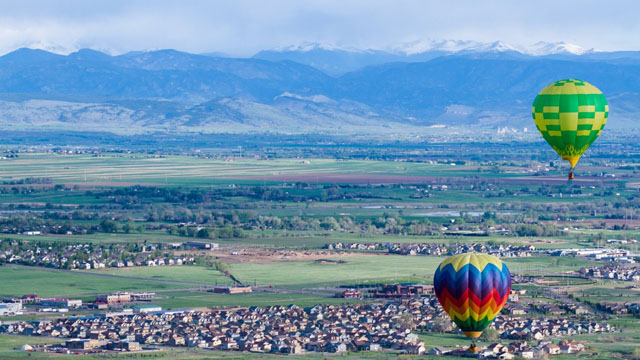Growing Pains
22 May 2023
As Boulder County’s population explodes, its towns and cities will need to rely even more on the resilience and community that brought so many people here in the first place
By MATT MAENPAA

“People seeing the beauty of this valley will want to stay, and their staying will be the undoing of the beauty.”
Chief Niwot’s well-worn quote referring to the natural wonder of Boulder Valley, known as Niwot’s Curse, has become something of a self-fulfilling prophecy. The lands that make up Boulder County remain beautiful, but there’s no denying the density of people who continue to take up residency in the hills and valleys, that were once home to the Arapaho and other Indigenous peoples.
One of the 17 original counties that made up Colorado when it became a state in 1876, Boulder County is now home to more than 300,000 people and has expanded well beyond the city that gave the county its name. Through fire, flood, plague and a constant shortage of housing, people continue to choose the valley as their home—and why wouldn’t they? Boulder County offers stunning mountain vistas and a relatively central location to places like Denver, Fort Collins and Rocky Mountain National Park, along with plenty of jobs and recreation.
The first recorded population census for the county in 1870 recorded a whopping 1,939 residents, according to Colorado State Archives. A hundred years later, in 1970, the population had multiplied to 131,889. A little over 50 years later, that number has almost tripled.
Big tech companies and manufacturers, from IBM, SeaGate and Google to Crocs and OtterBox, have all built big campuses. Towns like Erie and Superior have seen major growth since their initial incorporations, while the L-towns (Longmont, Louisville and Lafayette) continue to draw new residents and housing developments. Longmont’s population is on track to overtake Boulder’s in the next decade, with more than 100,000 people as of the last census.
Some of the appeal comes from the small-town vibes found in the L-towns’ quaint downtowns. If you follow Highway 287 from Longmont’s Main Street all the way into Lafayette and Louisville, you’ll find plenty of restaurants, art galleries and entertainment venues to choose from—and plenty of housing developments encroaching on once-open agricultural land.
Craig Engelhorn, the owner of Spirit Hound Distillery in Lyons and former master brewer for Oskar Blues, who has lived in the area for more than 26 years, says officials from the town of Superior reached out several years ago when it started having growing pains, to ask how Lyons had maintained its small-town feel as population boomed.
“Lyons is lucky, in a sense,” Engelhorn says. “We can’t support unbounded growth because we’re physically penned in. Whereas Superior and Lafayette, those are built on this wide-open space.”
Geographically restricted, Lyons runs into canyons, foothills and the junctions of streams that form the St. Vrain Creek. Other municipalities in the western reaches of the county, like Nederland, Jamestown and Ward, face similar restrictions that keep them smaller than their eastern counterparts.
Engelhorn says community has always been a core value at the distillery. “But we realized a long time ago, that it’s not just being a part of the community,” he adds. “It’s the community being a part of you. We give, and we take.”
Fires, Floods and Sprawl
Hardiness is a necessity for Boulder County residents. This year marks a decade since the 2013 flood ravaged the county, almost washing parts of Lyons off the map and leaving many residents without power for months.
Fire has been a constant threat. The 1989 Black Tiger Gulch Fire, which burned for four days and destroyed 44 homes on Sugarloaf Mountain and in Four Mile Canyon, caused $10 million in damage. It was the costliest wildfire in Colorado’s history at the time—and seems underwhelming today.
In 2020, as the COVID pandemic shut down the county, some of the largest wildfires in Colorado came dangerously close. Recovery and restoration efforts from nearly a million acres of wildfires, including the Calwood fire that burned more than 10,000 acres in Boulder County, are still ongoing.
Just over a year later, on December 30, 2021, the Marshall Fire claimed more than 1,000 structures in Louisville, Superior and unincorporated Boulder County, causing more than $1 billion in damage. Many residents are still struggling to find homes.
Still, people move here, and new developments are built to accommodate them. In his plans for his second term and the 2023 legislative session, Colorado Gov. Jared Polis promises to address the housing and transportation issues now facing the state and the county.
At a policy presentation with the Louisville-based Commuting Solutions group in January, Polis argued for denser neighborhoods over the continuing spread of housing developments into open space and agricultural lands. “We need to make sure we have thoughtful, smart planning, sustainable development and better transit services along transit-oriented communities that allow people to get to work in different ways,” Polis said.
Perhaps one day RTD’s mythical rail line from Denver to Fort Collins will actually be built, easing the commutes of thousands along the Front Range. While we wait, more subdivisions and developments will spring up in the county. According to the City of Longmont’s active development log, more than 1,000 units are under construction in that city alone.
A Future for Everyone
Boulder County Commissioner Marta Loachamin, a long-term Boulder County resident who now lives in Longmont, believes the county is ready to delve deep into the issues of housing and transportation.
“They just need leadership who will listen and people who are willing to work on these issues in a way that is fair and equitable for all residents,” she adds.
Before she became Boulder County’s first Latina commissioner, Loachamin worked as a teacher and a real estate agent and served as a cultural broker when the City of Longmont helped the community’s Latino population during the 2013 flood. Since she took office, she has continued the necessary work of making sure the government serves everyone who resides in the community, including people affected by COVID and fires.
Community resiliency is an important factor in its growth, but Loachamin wants to ensure that the conversation includes everyone.
“Resiliency and the future of the county must include those who exist outside of the system or are traditionally underserved by it,” she says.
In 2021, the county partnered with the Community Foundation for Boulder County and Rebuild by Design to conduct public outreach, surveys and forums to address the best way to allocate $63.35 million in federal funds through the American Rescue Plan Act, “to co-determine how the… funds will be used by community members who suffered in disparate ways due to racial, social and gender inequalities and set a precedent for future planning efforts,” according to the county’s November 2021 report on the allocations.
According to Loachamin, a goal of the current legislative session at both the state and county level will be to address creative solutions to the housing issues, including affordable developments and reassessing zoning restrictions. We can remain hopeful that the Boulder County Regional Housing Partnership can reach its goal of 12 percent permanently attainable housing in the county by 2035.
Boulder County Stats
Boulder County Population (US Census Bureau)
1970: 131,889
1980: 189,625
1990: 225,339
2000: 271,574
2010: 295,056
2021: 329,543
BoCo Square Footage: 740 square miles
School Districts: Boulder Valley RE-2, St. Vrain Valley RE 1J, Estes Park R-3, Thompson R-2J
Cities: Boulder, Longmont, Lafayette, Louisville
Towns: Erie, Jamestown, Lyons, Nederland, Superior, Ward












